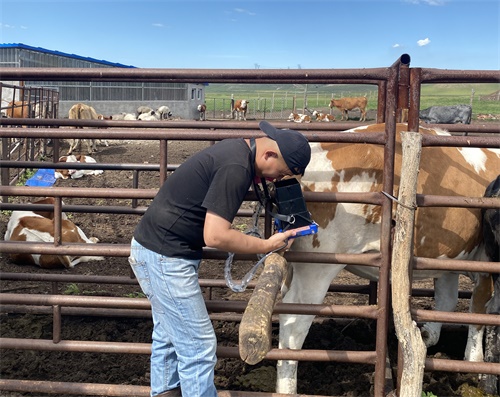In recent decades, the livestock industry has seen a technological revolution that reshaped how we monitor, breed, and manage cattle. Among these innovations, ultrasound technology has become an essential diagnostic and monitoring tool in both reproductive health and commercial cattle management. Used widely in veterinary medicine around the globe, ultrasound machines have evolved to serve more specialized roles, especially in reproductive monitoring and herd optimization. This article explores the current trends in cattle ultrasound machine development, with insights from international practices, and explains how this technology is becoming a core part of modern cattle farming strategies.
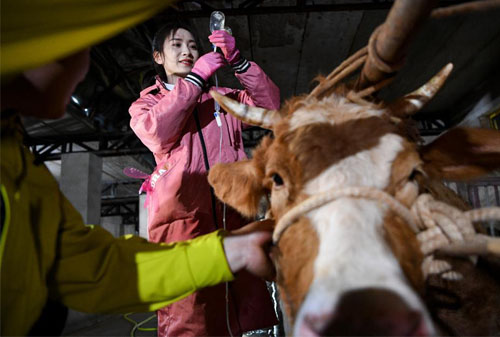
The Growing Importance of Reproductive Monitoring in Cattle
Efficient reproduction is the cornerstone of any successful cattle operation. Whether managing a dairy or beef herd, early pregnancy detection, ovarian status monitoring, and assessment of uterine health are critical to maintaining high reproductive efficiency.
Traditionally, rectal palpation was the standard method for diagnosing pregnancy and evaluating reproductive organs. However, it is limited by subjectivity and requires extensive experience. Ultrasound technology, particularly B-mode and Doppler ultrasound, has offered a more reliable, visual, and quantifiable alternative. Globally, countries like the United States, Australia, Canada, and parts of Europe have increasingly adopted ultrasound to monitor cattle reproduction, resulting in improved conception rates and better herd management outcomes.
Evolution of Ultrasound Machines for Cattle
Over the years, ultrasound machines have developed significantly in terms of portability, imaging quality, probe versatility, and user-friendliness. These improvements directly respond to farmers’ and veterinarians’ needs in the field.
Miniaturization and Portability
Early ultrasound systems were bulky and required stable electricity sources. Today, devices such as the BXL-V50 are lightweight, battery-operated, and rugged enough for on-farm use. These portable machines allow real-time diagnostics in barns or pastures, eliminating the need to transport animals to clinics.High-Resolution Imaging
Modern systems now offer high-definition (HD) imaging, essential for identifying structures like ovarian follicles, corpora lutea, early embryos, or uterine fluids. This precision helps differentiate between normal and abnormal reproductive states.Doppler Capabilities
Doppler ultrasound is being increasingly integrated into cattle scanning to evaluate blood flow. Blood perfusion in the corpus luteum or uterus provides valuable information on ovarian function and reproductive health.Wireless and Digital Data Management
Some ultrasound models now come with Wi-Fi or USB data export, allowing images to be stored, transferred, or analyzed remotely. In countries like New Zealand or Germany, this feature is particularly useful for integrating animal health records into farm management systems.
Key Applications in Reproductive Monitoring
1. Early Pregnancy Diagnosis
Using ultrasound, pregnancy can be confirmed as early as 28–30 days post-insemination. In beef and dairy herds, this shortens the time between failed insemination and re-breeding, thereby reducing days open.
2. Ovarian Monitoring
Ultrasound can identify follicular waves, monitor ovulation timing, and detect cysts or anestrus conditions. In breeding programs that use synchronization protocols, this tool ensures the timely and successful application of artificial insemination (AI).
3. Uterine Health Assessment
Detecting fluid accumulation, endometritis, or uterine involution disorders is easier and more accurate with ultrasound compared to manual palpation. In regions like Canada and the UK, ultrasound is commonly used post-calving to confirm uterine recovery.
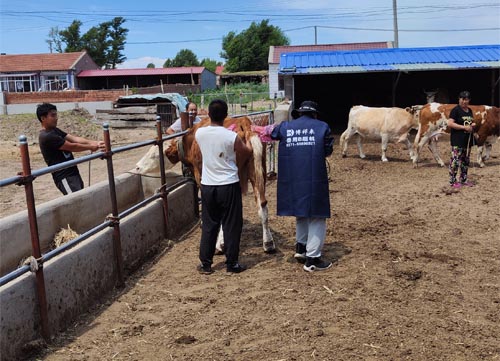
Trends in Commercial Sale of Cattle Ultrasound Equipment
With growing demand, the ultrasound equipment market for cattle has expanded rapidly. Several trends are defining the commercial landscape:
A. Rise in Demand for Multipurpose Devices
Farmers prefer machines that can do more than just reproductive scanning. Devices that also allow muscle evaluation, fat thickness measurement, and fetal sexing add more value. Multifunctional systems reduce the need for separate equipment and training.
B. Training and After-Sales Support
In many Western countries, including the US and Ireland, vendors offering on-site training and technical support see higher adoption rates. Farmers are more likely to invest in ultrasound systems when they are confident in their ability to use them effectively.
C. Cost-Effective Models for Small Farms
Manufacturers are developing more budget-friendly ultrasound machines without compromising diagnostic capabilities. This shift helps small and medium-sized farms in developing regions—like parts of Africa, Southeast Asia, and Latin America—access reproductive technology.
D. Customization for Field Conditions
Machines now feature dustproof and waterproof casings (often with IP56 rating), long battery life, and sun-readable screens, ensuring that veterinarians can work effectively under challenging outdoor conditions.
Case Study: Ultrasound Adoption in the U.S. Beef Industry
In the United States, commercial beef operations widely use ultrasound for both pregnancy detection and carcass trait evaluation. According to data from the National Beef Cattle Evaluation Consortium, ultrasound helps identify cattle with optimal marbling and muscle development. The ability to make genetic selection decisions early—based on measurable ultrasound traits—has significantly boosted productivity.
Reproductive ultrasound has also shortened calving intervals and reduced replacement rates by allowing producers to make fast, accurate breeding decisions. These benefits have led to widespread industry support and even government-funded training programs in some states.
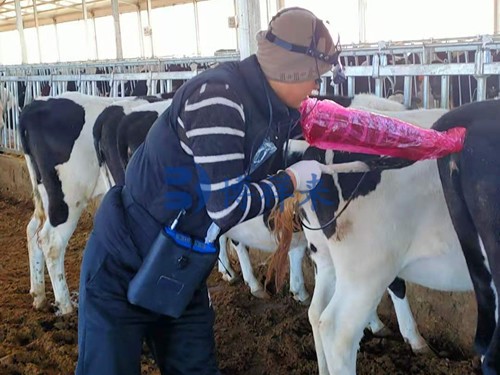
Challenges and Limitations
Despite the many benefits, ultrasound use in cattle still faces some limitations:
Operator Dependency: The effectiveness of ultrasound depends largely on the skill and experience of the user.
Cost of High-End Equipment: Advanced machines with Doppler and 3D imaging features remain costly and may be out of reach for small farms.
Learning Curve: Some farmers find it challenging to interpret ultrasound images without veterinary support.
However, the increasing availability of training modules, mobile apps, and cloud-based support systems is helping overcome these challenges, especially in countries that prioritize agricultural technology.
Future Directions
Several innovations are shaping the future of ultrasound in cattle farming:
Artificial Intelligence Integration: AI can help interpret ultrasound images and flag abnormalities, reducing dependence on expert operators.
Telemedicine Support: Ultrasound scans can be shared in real-time with veterinarians or AI platforms for remote diagnosis.
3D and Elastographic Imaging: These techniques provide even more detail, particularly for detecting uterine scarring or ovarian texture changes.
Wearable or Hands-Free Devices: Research is underway to develop wearable scanners for continuous monitoring during sensitive periods like estrus.
Conclusion
The development of ultrasound machines tailored for cattle reproduction and commercial use is transforming modern animal agriculture. From portable, high-resolution imaging systems to AI-assisted diagnostics, the industry is moving toward smarter, more efficient herd management. Farmers and veterinarians alike benefit from earlier pregnancy detection, better reproductive monitoring, and data-driven decision-making—all of which contribute to improved productivity and animal welfare.
As technology continues to evolve, ultrasound will become even more accessible, affordable, and indispensable for cattle operations worldwide. The trend toward multifunctional, user-friendly, and connected devices reflects a future where precise reproductive control becomes standard practice, not a luxury.
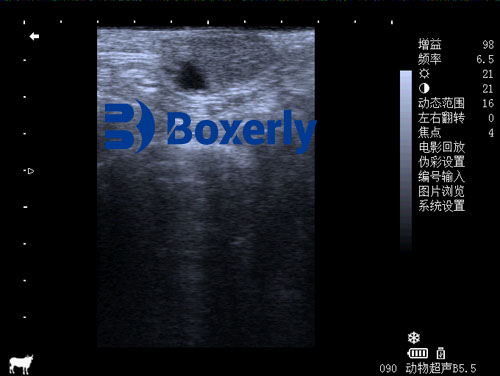
References:
Whitaker, D. A., & Smith, E. (2021). Veterinary Ultrasonography in Food-Producing Animals. Journal of Veterinary Imaging.
Beef Cattle Institute. (2023). Use of Ultrasound for Growth Evaluation in Cattle. https://www.beefcattleinstitute.org/ultrasound-growth
National Beef Cattle Evaluation Consortium (NBCEC). (2022). Carcass Ultrasound Guidelines. https://www.nbcec.org/resources/ultrasound
Agriculture and Horticulture Development Board (AHDB), UK. (2022). Cattle Fertility Management with Ultrasound. https://ahdb.org.uk/cattle-ultrasound-management
Food and Agriculture Organization (FAO). (2020). Technologies for Animal Health and Reproduction. https://www.fao.org/3/cb1792en/cb1792en.pdf



